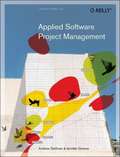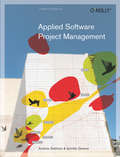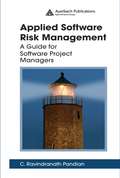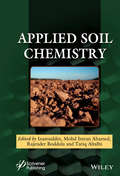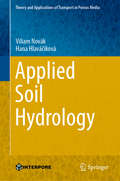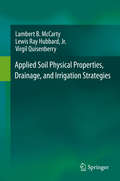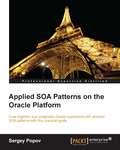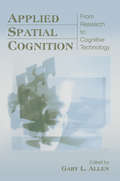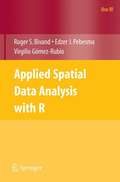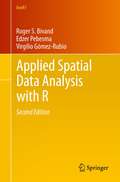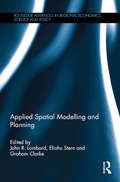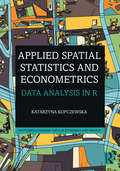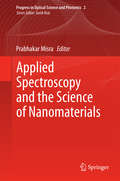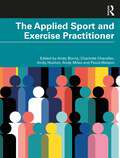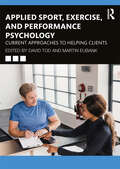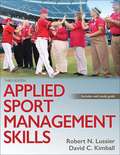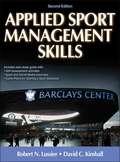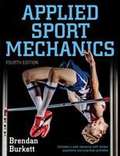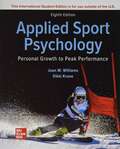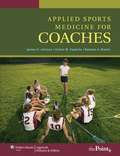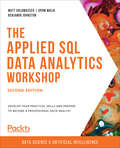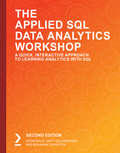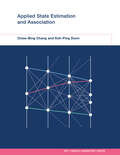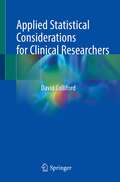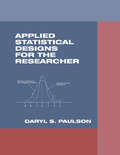- Table View
- List View
Applied Software Project Management
by Andrew Stellman Jennifer Greene"If you're looking for solid, easy-to-follow advice on estimation, requirements gathering, managing change, and more, you can stop now: this is the book for you." --Scott Berkun, Author of The Art of Project Management What makes software projects succeed? It takes more than a good idea and a team of talented programmers. A project manager needs to know how to guide the team through the entire software project. There are common pitfalls that plague all software projects and rookie mistakes that are made repeatedly--sometimes by the same people! Avoiding these pitfalls is not hard, but it is not necessarily intuitive. Luckily, there are tried and true techniques that can help any project manager. In Applied Software Project Management , Andrew Stellman and Jennifer Greene provide you with tools, techniques, and practices that you can use on your own projects right away. This book supplies you with the information you need to diagnose your team's situation and presents practical advice to help you achieve your goal of building better software. Topics include: Planning a software project Helping a team estimate its workload Building a schedule Gathering software requirements and creating use cases Improving programming with refactoring, unit testing, and version control Managing an outsourced project Testing software Jennifer Greene and Andrew Stellman have been building software together since 1998. Andrew comes from a programming background and has managed teams of requirements analysts, designers, and developers. Jennifer has a testing background and has managed teams of architects, developers, and testers. She has led multiple large-scale outsourced projects. Between the two of them, they have managed every aspect of software development. They have worked in a wide range of industries, including finance, telecommunications, media, nonprofit, entertainment, natural-language processing, science, and academia. For more information about them and this book, visit http://www.stellman-greene.com .
Applied Software Project Management
by Andrew Stellman Jennifer Greene"If you're looking for solid, easy-to-follow advice on estimation, requirements gathering, managing change, and more, you can stop now: this is the book for you."--Scott Berkun, Author of The Art of Project ManagementWhat makes software projects succeed? It takes more than a good idea and a team of talented programmers. A project manager needs to know how to guide the team through the entire software project. There are common pitfalls that plague all software projects and rookie mistakes that are made repeatedly--sometimes by the same people! Avoiding these pitfalls is not hard, but it is not necessarily intuitive. Luckily, there are tried and true techniques that can help any project manager.In Applied Software Project Management, Andrew Stellman and Jennifer Greene provide you with tools, techniques, and practices that you can use on your own projects right away. This book supplies you with the information you need to diagnose your team's situation and presents practical advice to help you achieve your goal of building better software.Topics include:Planning a software projectHelping a team estimate its workloadBuilding a scheduleGathering software requirements and creating use casesImproving programming with refactoring, unit testing, and version controlManaging an outsourced projectTesting softwareJennifer Greene and Andrew Stellman have been building software together since 1998. Andrew comes from a programming background and has managed teams of requirements analysts, designers, and developers. Jennifer has a testing background and has managed teams of architects, developers, and testers. She has led multiple large-scale outsourced projects. Between the two of them, they have managed every aspect of software development. They have worked in a wide range of industries, including finance, telecommunications, media, nonprofit, entertainment, natural-language processing, science, and academia. For more information about them and this book, visit stellman-greene.com
Applied Software Risk Management: A Guide for Software Project Managers
by C. Ravindranath PandianFew software projects are completed on time, on budget, and to their original specifications. Focusing on what practitioners need to know about risk in the pursuit of delivering software projects, Applied Software Risk Management: A Guide for Software Project Managers covers key components of the risk management process and the software development
Applied Soil Chemistry
by Inamuddin Mohd Imran Ahamed Rajender Boddula Tariq AltalhiThis book explores the state-of-the-art information regarding applied soil sciences. It covers the fundamentals, model concepts, principles, chemical reactions, functions, chemical recycling, chemical weathering, acid-base chemistry, carbon sequestration, and nutrient availability of soils. Also, it includes soil chemistry of heavy-metals, environment, clay, ion-exchange processes, analytical tools and applications. This book helps to understand the about soil characteristics targeting soil chemical reactions and interactions and its applications.
Applied Soil Hydrology (Theory and Applications of Transport in Porous Media #32)
by Hana Hlaváčiková Viliam NovákThis state-of-the-art book clearly explains the basic principles of soil hydrology and the current knowledge in this field. It particularly highlights the estimation and application of measurements and evaluation of soil-hydrophysical characteristics using simulation models, with a focus on elucidating the basic hydrophysical characteristics of soil, such as soil water potential and hydraulic conductivity, as well as the methods of measurement. It also addresses topics such as stony soil, water repellent soils, and water movement modeling in those media. The book presents soil hydrology in a simple way, while quantitatively expressing the soil water state and movement. It clearly and precisely describes basic terms of soil hydrology with a minimum of mathematics. It also includes the latest research findings in the field as well as the basics of the mathematical modeling of water movement in the soil-plant-atmosphere system (SPAS), using original research results to illustrate these issues.This book is of interest to all scientists and professionals in soil hydrology, including beginners, as well as those interested and working in hydrology in general and soil hydrology in particular. In addition, it can also be used by specialists and students in related fields like agronomy, forestry, meteorology, hydrology, environmental engineering, environmental protection, and geography.
Applied Soil Physical Properties, Drainage, and Irrigation Strategies.
by Lambert B. Mccarty Lewis Ray Hubbard Jr. Virgil QuisenberryThe book is a realistic blend of basic knowledge and understanding in soil physical properties. It will enable the reader to scientifically analyze soils to develop practical and successful means of providing sufficient drainage and to develop science-based irrigation strategies. Only basic mathematical knowledge is necessary to understand and apply the proven principles covered. With limited resources that are increasing significantly in costs, the book blends the ideal concept of providing sufficient drainage and irrigation based on using soil physical properties but with financial limitations in mind. One traditional problem with many Soil Physics, Drainage, and Irrigations-based texts is the prerequisite of understanding complicated calculus-based mathematics. Although necessary for a theory-based text, our text was developed with practitioners in mind where such complicated mathematics was avoided but referenced if the reader wishes to further explore the specific topic. Another problem with many traditional texts is the lack of practical examples or case-studies allowing readers to relate their specific scenarios to similar types of situations. We have purposely included numerous examples and practical field experiences. This is especially true when many of the theoretical ideals are covered, followed by explanations of how such ideals can be applied in the laboratory and field.
Applied SOA Patterns on the Oracle Platform
by Sergey PopovApplied SOA Patterns on the Oracle Platform is aimed at architects practicing SOA or traditional integration, and also at technical team leaders implementing Oracle Fusion under SCRUM or WF methodology.
Applied Spatial Cognition: From Research to Cognitive Technology
by Gary L. AllenApplied Spatial Cognition illustrates the vital link between research and application in spatial cognition. With an impressive vista ranging from applied research to applications of cognitive technology, this volume presents the work of individuals from a wide range of disciplines and research areas, including psychologists, geographers, information scientists, computer scientists, cognitive scientists, engineers, and architects. Chapters throughout the book are a testimony to the importance of basic and applied research regarding human spatial cognition and behavior in the many facets of daily life. The contents are arranged into three sections, the first of which deals with a variety of spatial problems in real-world settings. The second section focuses on spatial cognition in specific populations. The final part is concerned principally with applications of spatial cognitive research and the development of cognitive technology. Relevant to a number of remarkably diverse groups, Applied Spatial Cognition will be of considerable interest to researchers and professionals in industrial/organizational psychology, human factors research, and cognitive science.
Applied Spatial Data Analysis with R
by Roger Bivand Edzer J. Pebesma Virgilio Gómez-Rubio Roger S. BivandApplied Spatial Data Analysis with R is divided into two basic parts, the first presenting R packages, functions, classes and methods for handling spatial data. This part is of interest to users who need to access and visualise spatial data. Data import and export for many file formats for spatial data are covered in detail, as is the interface between R and the open source GRASS GIS. The second part showcases more specialised kinds of spatial data analysis, including spatial point pattern analysis, interpolation and geostatistics, areal data analysis and disease mapping. The coverage of methods of spatial data analysis ranges from standard techniques to new developments, and the examples used are largely taken from the spatial statistics literature. All the examples can be run using R contributed packages available from the CRAN website, with code and additional data sets from the book's own website. This book will be of interest to researchers who intend to use R to handle, visualise, and analyse spatial data. It will also be of interest to spatial data analysts who do not use R, but who are interested in practical aspects of implementing software for spatial data analysis. It is a suitable companion book for introductory spatial statistics courses and for applied methods courses in a wide range of subjects using spatial data, including human and physical geography, geographical information systems, the environmental sciences, ecology, public health and disease control, economics, public administration and political science.
Applied Spatial Data Analysis with R (Use R! #10)
by Virgilio Gómez-Rubio Roger S. Bivand Edzer PebesmaApplied Spatial Data Analysis with R, second edition, is divided into two basic parts, the first presenting R packages, functions, classes and methods for handling spatial data. This part is of interest to users who need to access and visualise spatial data. Data import and export for many file formats for spatial data are covered in detail, as is the interface between R and the open source GRASS GIS and the handling of spatio-temporal data. The second part showcases more specialised kinds of spatial data analysis, including spatial point pattern analysis, interpolation and geostatistics, areal data analysis and disease mapping. The coverage of methods of spatial data analysis ranges from standard techniques to new developments, and the examples used are largely taken from the spatial statistics literature. All the examples can be run using R contributed packages available from the CRAN website, with code and additional data sets from the book's own website. Compared to the first edition, the second edition covers the more systematic approach towards handling spatial data in R, as well as a number of important and widely used CRAN packages that have appeared since the first edition. This book will be of interest to researchers who intend to use R to handle, visualise, and analyse spatial data. It will also be of interest to spatial data analysts who do not use R, but who are interested in practical aspects of implementing software for spatial data analysis. It is a suitable companion book for introductory spatial statistics courses and for applied methods courses in a wide range of subjects using spatial data, including human and physical geography, geographical information science and geoinformatics, the environmental sciences, ecology, public health and disease control, economics, public administration and political science. The book has a website where complete code examples, data sets, and other support material may be found: http://www.asdar-book.org. The authors have taken part in writing and maintaining software for spatial data handling and analysis with R in concert since 2003.
Applied Spatial Modelling and Planning (Routledge Advances in Regional Economics, Science and Policy)
by John R. Lombard, Eliahu Stern and Graham ClarkeThis book highlights the extraordinary range of areas to which geographical analysis and spatial modelling can bring lessons and insights. It shows how these techniques have been used to address ‘real world’ issues that are of concern to international organisations, public agencies and businesses, as illustrated by actual funded projects that geographers have developed collaboratively with end-users. Applied Spatial Modelling and Planning shows how much geographical research is policy relevant to a wide variety of agencies through the use of GIS and spatial modelling in applied geography. The book’s chapters contain a cross-section of innovative applications and approaches to problem solving within five major domains of the dynamics of economic space, housing and settlements, population movements and population ageing, health care, and the environment. Using a number of case studies on the use of GIS and spatial modelling, this book demonstrates the fact that much of what is done by quantitative geographers is not only relevant within academia, but also has use in policy work. This book will appeal to an international audience interested in cutting-edge spatial modelling to better understand the processes involved in solving real problems.
Applied Spatial Statistics and Econometrics: Data Analysis in R (Routledge Advanced Texts in Economics and Finance)
by Katarzyna KopczewskaThis textbook is a comprehensive introduction to applied spatial data analysis using R. Each chapter walks the reader through a different method, explaining how to interpret the results and what conclusions can be drawn. The author team showcases key topics, including unsupervised learning, causal inference, spatial weight matrices, spatial econometrics, heterogeneity and bootstrapping. It is accompanied by a suite of data and R code on Github to help readers practise techniques via replication and exercises. This text will be a valuable resource for advanced students of econometrics, spatial planning and regional science. It will also be suitable for researchers and data scientists working with spatial data.
Applied Spectroscopy and the Science of Nanomaterials (Progress in Optical Science and Photonics #2)
by Prabhakar MisraThis book focuses on several areas of intense topical interest related to applied spectroscopy and the science of nanomaterials. The eleven chapters in the book cover the following areas of interest relating to applied spectroscopy and nanoscience: · Raman spectroscopic characterization, modeling and simulation studies of carbon nanotubes, · Characterization of plasma discharges using laser optogalvanic spectroscopy, · Fluorescence anisotropy in understanding protein conformational disorder and aggregation, · Nuclear magnetic resonance spectroscopy in nanomedicine, · Calculation of Van der Waals interactions at the nanoscale, · Theory and simulation associated with adsorption of gases in nanomaterials, · Atom-precise metal nanoclusters, · Plasmonic properties of metallic nanostructures, two-dimensional materials, and their composites, · Applications of graphene in optoelectronic devices and transistors, · Role of graphene in organic photovoltaic device technology, · Applications of nanomaterials in nanomedicine.
The Applied Sport and Exercise Practitioner
by Andy Borrie Charlotte Chandler Andy Hooton Andy Miles Paula WatsonThe Applied Sport and Exercise Practitioner is designed to help all developing sport and exercise practitioners navigate the world of applied work. This book explores conceptual issues surrounding applied practice such as the identity and role of the applied practitioner, professional ethics and how to be part of a multi-disciplinary team. Using a cross disciplinary approach, it brings together the challenges and experiences of sport and exercise practitioners. This book links theoretical ideas with actual practice and compares issues across disciplines and domains. Each chapter includes case studies of contemporary issues from practitioners working in different environments and with diverse populations. Important topics such as insurance, data protection, ethic and soft skills are also discussed. The Applied Sport and Exercise Practitioner is key reading for graduate students and practitioners interested in improving their practice and careers.
Applied Sport, Exercise, and Performance Psychology: Current Approaches to Helping Clients
by David TodApplied sport, exercise, and performance psychology practice has diversified considerably over the years, as consultants have explored various theoretical models to guide them in helping their clients. Applied Sport, Exercise, and Performance Psychology: Current Approaches to Helping Clients provides in-depth and critical coverage, from a global perspective, of the common approaches practitioners now use with clients. Chapters are supplemented with case studies showing the approaches in action. The text explores topics such as: Cognitive behavioural approaches Psychodynamics approaches Family systems therapy approaches Mindfulness approaches Practitioner training and development Cultural considerations in practice Evidence-based practice This text is a vital resource for students in applied sport psychology courses, sport and exercise science courses, and psychology and counselling courses. It is also an invaluable read for practicing applied sport, exercise, and performance psychologists, as well as coaches and parents with some background in psychology.
Applied Sport Management Skills
by Robert Lussier David Kimball<p>Applied Sport Management Skills, Third Edition With Web Study Guide, takes a unique and effective approach to teaching students how to become strong leaders and managers in the world of sport. Organized around the central management functions—planning, organizing, leading, and controlling—this third edition addresses the Common Professional Component topics outlined by the Commission on Sport Management Accreditation (COSMA). <p>The text explains important concepts but then takes the student beyond theories, to applying those management principles and developing management skills. This practical how-to approach, accompanied by unmatched learning tools, helps students put concepts into action as sport managers—developing the skills of creative problem solving and strategic planning, and developing the ability to lead, organize, and delegate.</p>
Applied Sport Management Skills 2nd Edition
by Robert N. Lussier David C. KimballApplied Sport Management Skills, Second Edition uses the four management functions of planning, organizing, leading, and controlling to teach students how to become strong leaders and managers in the world of sport. This comprehensive and fully updated text provides an overview of management topics with a unique focus on developing the skills necessary for managing sport organizations.
Applied Sport Psychology: Personal Growth to Peak Performance
by Jean M. Williams Professor Vikki KraneApplied Sport Psychology, Eighth Edition, presents to the reader sport psychological theories, strategies, and techniques used by coaches and sport psychologists to cultivate peak performance and personal growth. Williams and Krane bridge the gap between research and practice by using examples, exercises, case studies, and anecdotes―helping students to think more critically and to apply their knowledge to real-world situations. This Eighth Edition includes a new chapter on mindfulness in sport and updates that reflect the latest statistics and research from the field.
Applied Sports Medicine for Coaches
by James Johnson Esther Haskvitz Barbara BrehmWritten for coaches, this textbook explains what you need to know about sports medicine in order to integrate optimal performance training with an injury prevention program. Moreover, it helps you communicate effectively with health professionals and better understand the nature of an injury, its treatment, the injured athlete's limits, and his or her rehabilitation needs.
The Applied SQL Data Analytics Workshop: Develop your practical skills and prepare to become a professional data analyst, 2nd Edition
by Matt Goldwasser Upom Malik Benjamin JohnstonTake a step-by-step approach to learning SQL data analysis in this interactive workshop that uses fun exercises and activities to make learning data analytics for beginners easy and approachable. Key Features Explore ways to use SQL for data analytics and gain key insights from your data Study advanced analytics, such as geospatial and text analytics Discover ways to integrate your SQL pipelines with other analytics technologies Book Description Every day, businesses operate around the clock and a huge amount of data is generated at a rapid pace. Hidden in this data are key patterns and behaviors that can help you and your business understand your customers at a deep, fundamental level. Are you ready to enter the exciting world of data analytics and unlock these useful insights? Written by a team of expert data scientists who have used their data analytics skills to transform businesses of all shapes and sizes, The Applied SQL Data Analytics Workshop is a great way to get started with data analysis, showing you how to effectively sieve and process information from raw data, even without any prior experience. The book begins by showing you how to form hypotheses and generate descriptive statistics that can provide key insights into your existing data. As you progress, you'll learn how to write SQL queries to aggregate, calculate and combine SQL data from sources outside of your current dataset. You'll also discover how to work with different data types, like JSON. By exploring advanced techniques, such as geospatial analysis and text analysis, you'll finally be able to understand your business at a deeper level. Finally, the book lets you in on the secret to getting information faster and more effectively by using advanced techniques like profiling and automation. By the end of The Applied SQL Data Analytics Workshop, you'll have the skills you need to start identifying patterns and unlocking insights in your own data. You will be capable of looking and assessing data with the critical eye of a skilled data analyst. What you will learn Understand what data analytics is and why it is important Experiment with data analytics using basic and advanced queries Interpret data through descriptive statistics and aggregate functions Export data from external sources using powerful SQL queries Work with and manipulate data using SQL joins and constraints Speed up your data analysis workflow by automating tasks and optimizing queries Who this book is for If you are a database engineer who is looking to transition into analytics or someone who knows SQL basics but doesn't know how to use it to create business insights, then this book is for you.
The Applied SQL Data Analytics Workshop: A Quick, Interactive Approach to Learning Analytics with SQL, 2nd Edition
by Upom Malik Matt Goldwasser Benjamin JohnstonCut through the noise and get real results with a step-by-step approach to learning about SQL data analysis Key Features Ideal for SQL beginners who are getting started with data analytics for the first time A step-by-step SQL tutorial with exercises and activities that help build key skills Structured to let you progress at your own pace, on your own terms Use your physical print copy to redeem free access to the online interactive edition Book Description You already know that you want to learn data analysis with SQL, and a smarter way to learn is to learn by doing. The Applied SQL Data Analytics Workshop focuses on building up your practical skills so that you can navigate and compose custom reports like an expert data analyst. You'll learn from real examples that lead to real results. Throughout The Applied SQL Data Analytics Workshop, you'll take an engaging step-by-step approach to understand data analytics with SQL. You won't have to sit through any unnecessary theory. You can jump into a single exercise each day if you're short on time, or you can spend an entire weekend tinkering with SQLAlchemy and Python. It's your choice. Learning on your terms, you'll build up and reinforce key skills in a way that feels rewarding. Every physical print copy of The Applied SQL Data Analytics Workshop unlocks access to the interactive edition. With videos detailing all exercises and activities, you'll always have a guided solution. You can also benchmark yourself against assessments, track progress, and receive content updates. You'll even earn a secure credential that you can share and verify online upon completion. It's a premium learning experience that's included with your printed copy. To redeem, follow the instructions located at the start of your book. Fast-paced and direct, The Applied SQL Data Analytics Workshop is the ideal companion for SQL beginners. You'll perform SQL queries like a professional data scientist, learning along the way. This process means that you'll find that your new skills stick, embedded as best practice. A solid foundation for the years ahead. What you will learn Experiment with data analytics using basic and advanced queries Learn data interpretation through descriptive statistics and aggregate functions Export data from outside sources using powerful SQL queries Discover how to work with and manipulate data using SQL joins and constraints Speed up your data analysis workflow by automating tasks and optimizing queries Discover different advanced analytics techniques, including geospatial and text analysis Who this book is for Our goal at Packt is to help you be successful, in whatever it is you choose to do. The Applied SQL Data Analytics Workshop is an ideal tutorial for the beginner who wants to perform data analysis with SQL and is just getting started. Pick up a Workshop today, and let Packt help you develop skills that stick with you for life.
Applied State Estimation and Association (MIT Lincoln Laboratory Series)
by Chaw-Bing Chang Keh-Ping DunnA rigorous introduction to the theory and applications of state estimation and association, an important area in aerospace, electronics, and defense industries. Applied state estimation and association is an important area for practicing engineers in aerospace, electronics, and defense industries, used in such tasks as signal processing, tracking, and navigation. This book offers a rigorous introduction to both theory and application of state estimation and association. It takes a unified approach to problem formulation and solution development that helps students and junior engineers build a sound theoretical foundation for their work and develop skills and tools for practical applications. Chapters 1 through 6 focus on solving the problem of estimation with a single sensor observing a single object, and cover such topics as parameter estimation, state estimation for linear and nonlinear systems, and multiple model estimation algorithms. Chapters 7 through 10 expand the discussion to consider multiple sensors and multiple objects. The book can be used in a first-year graduate course in control or system engineering or as a reference for professionals. Each chapter ends with problems that will help readers to develop derivation skills that can be applied to new problems and to build computer models that offer a useful set of tools for problem solving. Readers must be familiar with state-variable representation of systems and basic probability theory including random and stochastic processes.
Applied Statistical Considerations for Clinical Researchers
by David CullifordThis essential book details intermediate-level statistical methods and frameworks for the clinician and medical researcher with an elementary grasp of health statistics and focuses on selecting the appropriate statistical method for many scenarios. Detailed evaluation of various methodologies familiarizes readers with the available techniques and equips them with the tools to select the best from a range of options. The inclusion of a hypothetical case study between a clinician and statistician charting the conception of the research idea through to results dissemination enables the reader to understand how to apply the concepts covered into their day-to-day clinical practice.Applied Statistical Considerations for Clinical Researchers focuses on how clinicians can approach statistical issues when confronted with a medical research problem by considering the data structure, how this relates to their study's aims and any potential knock-on effects relating to the evidence required to make correct clinical decisions. It covers the application of intermediate-level techniques in health statistics making it an ideal resource for the clinician seeking an up-to-date resource on the topic.
Applied Statistical Designs for the Researcher (Chapman & Hall/CRC Biostatistics Series)
by Daryl S. PaulsonShowcasing a discussion of the experimental process and a review of basic statistics, this volume provides methodologies to identify general data distribution, skewness, and outliers. It features a unique classification of the nonparametric analogs of their parametric counterparts according to the strength of the collected data. Applied Statistical Designs for the Researcher discusses three varieties of the Student t test, including a comparison of two different groups with different variances; two groups with the same variance; and a matched, paired group. It introduces the analysis of variance and Latin Square designs and presents screening approaches to comparing two factors and their interactions.
